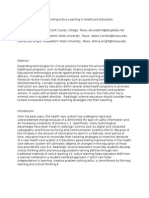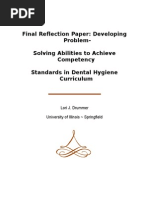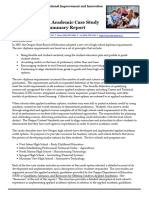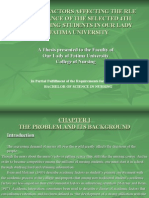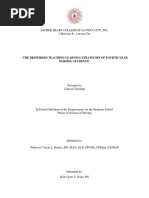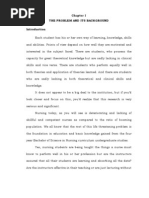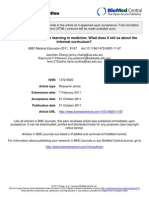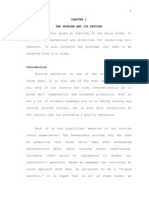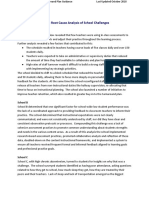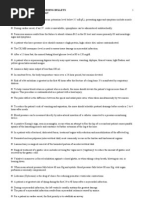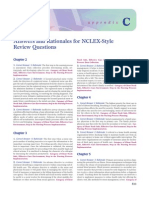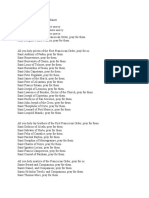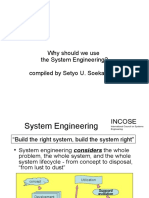Improving NCLEX Scores With Structured Learning Assistance: Arlene M. Morton, MSN, RN, CFNP
Improving NCLEX Scores With Structured Learning Assistance: Arlene M. Morton, MSN, RN, CFNP
Uploaded by
Jacinth Florido FedelinCopyright:
Available Formats
Improving NCLEX Scores With Structured Learning Assistance: Arlene M. Morton, MSN, RN, CFNP
Improving NCLEX Scores With Structured Learning Assistance: Arlene M. Morton, MSN, RN, CFNP
Uploaded by
Jacinth Florido FedelinOriginal Description:
Original Title
Copyright
Available Formats
Share this document
Did you find this document useful?
Is this content inappropriate?
Copyright:
Available Formats
Improving NCLEX Scores With Structured Learning Assistance: Arlene M. Morton, MSN, RN, CFNP
Improving NCLEX Scores With Structured Learning Assistance: Arlene M. Morton, MSN, RN, CFNP
Uploaded by
Jacinth Florido FedelinCopyright:
Available Formats
NURSE EDUCATOR Volume 31, Number 4, pp 163165 * 2006 Lippincott Williams & Wilkins, Inc.
uch has been written about the best way to prepare nursing students for the National Council Licensure Examination-RN exam (NCLEX). Authors agree that some form of remediation should be offered if the student fails an exit examination.1-3 Evidence of the benefits of remediation is well documented in the literature. A study by Farmer-Hinton4 found that elementary students made gains in reading and math when extra instructional time was offered. Elder and Paul,5 in their article on critical thinking, discussed the importance of teaching students how to study and learn by opening their minds to new concepts and thinking within the concept. At the community college level, Perin6(p54) writes, A key to effective remediation seems to build in support systems and teaching mechanisms that focus directly on student needs and interests. A study by Stewart et al7 addressed the issue of nursing students use of learning support services. The authors found that significantly more older students independently sought out learning support, the most frequent excuse for not attending support services was time issues (ie, work, family), and students who perceived support as an empowering strategy were more likely to attend. Where nursing authors differ is on the question of who, when, and how remediation should occur. What should be the deciding factor for who needs remediation? Is end-ofprogram remediation too late? What is the best way to provide meaningful remediation? When our NCLEX pass rate fell to 65%, a taskforce was formed
Improving NCLEX Scores With Structured Learning Assistance
Arlene M. Morton, MSN, RN, CFNP
Many faculty struggle to find the best way to prepare their nursing students for the NCLEX exam. Nursing faculty at Ferris State University identified, along with other issues, a lack of structured remediation throughout students clinical courses. The author explains how NCLEX review was incorporated into an existing university-wide remediation program, resulting in an increase in our students pass rates from 65% to 92%.
to try to identify the problem areas and develop strategies for remediation.
Structured Learning Assistance
University SLA workshops began in 1993 as a way to help students master course content and develop successful learning strategies. The program originated out of the realization that underachieving students were not using the existing academic support services on campus. Students seemed hesitant to use tutoring services and those who did were already doing well in their courses. Existing study skills courses were too generic in nature to assist the students in specific course content. Students who needed the most academic support were not receiving it because there was no mechanism in place to mandate their participation.8 Since 1993, the SLA workshops have been an efficient and economical way to reach a large number of university students who need study and learning skills. Consistent with research findings of effective remediation, SLA provides extra instruction time that a student must appropriately time-manage, teaches students how to study, and focuses directly on students needs and interests. The University SLA program provides 2 to 4 extra hours weekly of mandatory study and practice workshops attached to courses with a history of high failure rates. The workshops
NCLEX Taskforce
The School of Nursing NCLEX Taskforce determined that there were several problem areas contributing to the students poor performance on the NCLEX exam; curriculum content for each course was not clearly defined, testing throughout the program did not always address critical thinking using application questions, students who had a history of poor academic performance were not identified early in the program as at-risk students, and there was no remediation plan in place throughout the students program of study. As a result of these findings, faculty developed standard curriculum grids so that each student is provided with consistent and complete content. Faculty attended test construction workshops that helped them develop higher-level questions for their courses. In addition, diagnostic computer testing programs, including course-specific exams, midcurricular, and exit examinations, were reviewed and purchased. Finally, the taskforce recommended incorporating content-specific NCLEX review questions into existing university structured learning assistance (SLA) workshops.
Author Affiliation: Associate Professor, School of Nursing, Ferris State University, Big Rapids, Mich. Correspondence: Ferris State University, 200 Ferris Drive, Big Rapids, MI 49307 (mortona@ ferris.edu). Reprinted with permission from Morton AM. Improving NCLEX scores with structured learning assistance. Nurse Educ 2006; 31(4): 163165.
CIN: Computers, Informatics, Nursing Nurse Educator September/October 2008 Supplement
89S
emphasize course content and teach study skills and learning strategies as they directly apply to a content area. Each workshop is facilitated by a trained paraprofessional who collaborates with the professor to develop materials to use in the workshop. Workshop activities include reviewing study guides of lecture topics, receiving homework assistance, preparing for tests, and working through exercises to develop students note-taking and time- management skills.
SLA Rules
Specific attendance and conduct policies have been developed that provide structure and motivate participation in SLA. Each professor, with a workshop attached to his or her course, sets the average course grade for required SLA attendance. Students required to attend are only allowed 2 to 4 (depending on how many times a week the workshop is held) unexcused absences without penalty. Tardiness is defined as arriving more than 5 minutes after the scheduled time the workshop is to start. For every 3 times a student is late for the workshop session, they receive 1 unexcused absence. If the student exceeds the number of allowed absences, they are required to withdraw from the didactic course or receive a failing grade. Students who have maintained a course average above the SLA attendance requirement are encouraged to attend the workshops voluntarily but are not required to follow the attendance policies. There are also expectations for student participation in the workshop and specific rules of conduct. At the beginning of each semester, the SLA attendance and workshop policy is reviewed with the students, and they are required to sign a statement of understanding.
jority of the students felt the SLA workshops were instrumental in their achieving a passing or higher grade. More than half of the students in SLA attended voluntarily attesting to the value of the workshops. Seventy-nine percent of the students felt facilitators were effective to very effective in conducting the workshops. The overall cost per student to run the university SLA program is approximately $42 per class seat and is provided by either grant money or university funding allocations, so there is no additional cost to the student who attends SLA workshops. A student receives essentially free tutoring and a better chance of success in the course.
SLA for Nursing and NCLEX Review
The members of the NCLEX taskforce realized that SLA would be the perfect format for incorporating NCLEX review all 4 semesters at no extra cost to the student. University SLA workshops are now attached to the nursing pharmacology course offered the first clinical semester and the 3 medical/ surgical nursing courses offered the second, third, and fourth clinical semesters. Because research shows that students who obtain higher grades in nursing courses are more likely to pass the NCLEX examination,912 students who have less than an 850 average (B) in the course are required to attend SLA. Also, at the end of the first year HESI custom exam, a score of 850 predicts a passing score on NCLEX. If a student has not achieved the 850 or higher, the student must attend SLA the following year no matter what his/ her course average is. About two thirds of the students attend the workshops either because they are required to or because they want to achieve a higher course grade. In the past 3 years, approximately 110 students have gone through this program.
SLA Evaluation
The students perform an evaluation of the university SLA program at the end of each academic year. Each year, pass rates for students who attended the workshops are higher than for students in identical courses without SLA workshops. At the end of the 2003-2004 academic year, Ferris had 60 sections of SLA workshops. A ma-
Facilitator Role
The professor for the course and the nursing department head identify facilitators for the nursing SLA workshops who are well-qualified nurses
and skilled teachers. Once chosen, the facilitator and the professor work together as a team. After attending the weekly lecture and meeting with the professor, facilitators clarify and enhance the content covered each week and help the students develop learning strategies so they can apply the information. Being a clinically competent nurse helps the facilitator bring real life examples to the students, making application easier. In our medical/surgical courses, the facilitator brings equipment, forms, and case examples from the hospital setting to help the students with their hands-on learning. She demonstrates effective note-taking techniques, good study habits, and application of content. Not only does a good facilitator offer learning strategies that provide transferable skills throughout the students academic career but he or she creates an extension of the learning environment beyond the didactic classroom. This extension includes NCLEX review questions pertaining to weekly didactic content. Structured learning assistance workshops are divided into two 1hour sessions. The first hour of the SLA workshop is devoted to understanding the weekly class content. For example, the week that diabetes mellitus is covered in class, the facilitator has the students work in groups analyzing the local hospitals admission physicians order form for the diabetic client. Each group has to identify rationales for each order. Discussion follows with the facilitator helping the students understand the why for each order, and thus, helping with the learning process. We require students to purchase a specified NCLEX review book their first clinical semester. During the second hour of SLA, students practice answering NCLEX questions specific to the content being reviewed. The facilitator helps the students critically think through the questions by identifying rationales for right and wrong answers. Discussions that follow further enhance the learning process. Facilitators often identify students who are having difficulty applying the information and then work more closely with them or alert the professor of the at-risk student. The facilitator may also use collaborative
90S
CIN: Computers, Informatics, Nursing Nurse Educator September/October 2008 Supplement
learning by having the students work to answer NCLEX questions in groups. This is especially helpful once the custom or exit examinations have been taken, and students are aware of their areas of weakness. Groups with similar needs (eg, students who tested poorly on postnatal care) can then be formed, allowing the students to concentrate their remediation in those areas.
shops throughout the students program of study played a major role in a students success.
7.
References
1. Daley LK, Kirkpatrick BL, Frazier SK, Chung ML. Predictors of NCLEX-RN success in a baccalaureate nursing program as a foundation for remediation. J Nurs Educ. 2003;42(9):390-398. 2. Engelmann ML. An Exploration of Strategies to Help Students Identified at Risk for Passing NCLEX and Implications for Nurse Educators. DeKalb, Ill: Northern Illinois University; 2002:132. 3. Morrison S, Free KW, Newman M. Do progression and remediation policies improve NCLEX-RN pass rates? Nurs Educ. 2002;27(2):94-96. 4. Farmer-Hinton R. When Time Matters: Examining the Impact and Distribution of Extra Instructional Time. Illinois; 2002. 5. Elder L, Paul R. Critical thinking: teaching students how to study and learn (Part II). J Dev Educ. 2002;26(2):34-35. 6. Perin D. Promising approaches for reme8.
9.
Conclusion
Nursing students need a systematic integration of NCLEX review. Structured learning assistance workshops can provide study skills, increased understanding of course content, and an opportunity to practice NCLEX questions. Within 2 years of implementing the NCLEX taskforce recommendations, the School of Nursings NCLEX pass percentage went from 65% to 92%. Incorporating NCLEX review questions into the SLA work-
10.
11.
12.
diation. Community Coll J. 2001;72(1): 53-56. Stewart L, Mort P, McVeigh C. Barriers and gateways: a study of nursing students utilization of learning support resources. Nurse Educ Today. April 2001; 21(3):209-297. Doyle T. Ferris State Universitys structured learning assistance program. Michigan Developmental Education Consortium Newsletter. 1999:4-8. Lengacher CA, Keller R. Academic predictors of success on the NCLEX-RN examination for associate degree nursing students. J Nurs Educ. 1990;29(4):163-169. Moore JF. An Investigation of Multiple Variables to Measure Success in a Baccalaureate Nursing Program. Laramie, Wyo: University of Wyoming; 1989:94. Roncoli M, Lisanti P, Falcone A. Characteristics of baccalaureate graduates and NCLEX-RN performance. J NY State Nurses Assoc. 2000;31(1):17-19. Woodham R, Taube K. Relationahip of nursing program predictors and success on the NCLEX-RN examination for licensure in a selected associate degree program. J Nurs Educ. 1986;25(3):112-117.
CIN: Computers, Informatics, Nursing Nurse Educator September/October 2008 Supplement
91S
You might also like
- Dale Carnegie - High Impcat PresentationsDocument4 pagesDale Carnegie - High Impcat Presentationstaiichiohno100% (3)
- Lisa Nichols No Matter What Life Assessment PDFDocument4 pagesLisa Nichols No Matter What Life Assessment PDFAmina Kika100% (2)
- Teaching Strategies Promoting Active Learning in Healthcare EducationDocument14 pagesTeaching Strategies Promoting Active Learning in Healthcare EducationGlenn Asuncion Pagaduan100% (1)
- Concept of Faculty Supervisor (Dual) Position: SupervisionDocument6 pagesConcept of Faculty Supervisor (Dual) Position: SupervisionAru Verma100% (3)
- Dufour Harnessing The Power of PlcsDocument7 pagesDufour Harnessing The Power of Plcsapi-339284287100% (1)
- BS-3262 - Part 3 PDFDocument11 pagesBS-3262 - Part 3 PDFCornel Tryphone0% (3)
- Teaching Strategies of Nursing Faculty and Academic Performance of Nursing StudentsDocument55 pagesTeaching Strategies of Nursing Faculty and Academic Performance of Nursing StudentsCj AguilarNo ratings yet
- UIS EDL 543 Final Reflection PaperDocument11 pagesUIS EDL 543 Final Reflection PaperKen M. SibzNo ratings yet
- Academic Case Study Summary ExampleDocument6 pagesAcademic Case Study Summary Examplethaovy.24082005No ratings yet
- NUR274 Williams Hopper 10FLDocument15 pagesNUR274 Williams Hopper 10FLkarl_poorNo ratings yet
- Intensive Interventions For Students Struggling in Reading & MathDocument60 pagesIntensive Interventions For Students Struggling in Reading & MathMia JacksonNo ratings yet
- Ctqpolicybriefon TCHR Training Andprofdev 021810Document12 pagesCtqpolicybriefon TCHR Training Andprofdev 021810emmanuelcaddaliNo ratings yet
- Thesis Power PointDocument30 pagesThesis Power Pointmary anne100% (1)
- What Is Preservice Education?Document9 pagesWhat Is Preservice Education?Mat GarciaNo ratings yet
- Research PaperDocument6 pagesResearch PaperJemerah AbendanioNo ratings yet
- Intensive Interventions For Students Struggling in Reading & Math - 2Document60 pagesIntensive Interventions For Students Struggling in Reading & Math - 2florafauna123No ratings yet
- Peer Mentoring Untapped PotentialDocument4 pagesPeer Mentoring Untapped PotentialVictor Manuel Enriquez GNo ratings yet
- An Online Evaluation of Problem-Based Learning (PBL) in Chung Shan Medical University, Taiwan - A Pilot StudyDocument10 pagesAn Online Evaluation of Problem-Based Learning (PBL) in Chung Shan Medical University, Taiwan - A Pilot StudykitsilcNo ratings yet
- Effects of Expectation of Ques-True-Experimental-DesignDocument5 pagesEffects of Expectation of Ques-True-Experimental-DesignNikka TusoNo ratings yet
- Uts Coursework Assessment PolicyDocument4 pagesUts Coursework Assessment Policyafjwduenevzdaa100% (2)
- Standard Book 10Document11 pagesStandard Book 10Ruth OyeyemiNo ratings yet
- Artifact 7Document5 pagesArtifact 7api-518231628No ratings yet
- The Future of Modular System of Medical Education: A Teachers' PerspectiveDocument8 pagesThe Future of Modular System of Medical Education: A Teachers' PerspectiveDilawar JanNo ratings yet
- Factors Affecting Student Motivation: Perception of Pre-Clinical Students in The College of Medicine, King Faisal University, Dammam, Saudi ArabiaDocument9 pagesFactors Affecting Student Motivation: Perception of Pre-Clinical Students in The College of Medicine, King Faisal University, Dammam, Saudi ArabiaProf. Dr. Sattar AlmaniNo ratings yet
- Nursing Thesis ExampleDocument10 pagesNursing Thesis ExampleLyka Milo AvilaNo ratings yet
- Test and Measurement As Administrative ADocument4 pagesTest and Measurement As Administrative ALhan Nie TangguidNo ratings yet
- 505 FinalProjectDocument14 pages505 FinalProjecttarapetersNo ratings yet
- Assignment Muhammad Areeb Shahid F2016054059 Submit To: Mam Khaula ShahidDocument4 pagesAssignment Muhammad Areeb Shahid F2016054059 Submit To: Mam Khaula ShahidAreeb ShahidNo ratings yet
- Research ProposalDocument2 pagesResearch ProposalKlare TyNo ratings yet
- Education Project The Importance of Professional Development For EducatorsDocument20 pagesEducation Project The Importance of Professional Development For EducatorsORUETU JOELNo ratings yet
- Research Journal of Internatıonal StudıesDocument16 pagesResearch Journal of Internatıonal StudıesShamsher ShirazNo ratings yet
- Module 5Document20 pagesModule 5Cyrus NadaNo ratings yet
- Monitoring Student LearningDocument15 pagesMonitoring Student LearningMos CraciunNo ratings yet
- A7 - Chapter I 3-13-11Document11 pagesA7 - Chapter I 3-13-11Makil SellarimNo ratings yet
- Running Head: HPT Solutions and Evaluation PlanDocument17 pagesRunning Head: HPT Solutions and Evaluation Planapi-270600640No ratings yet
- Maksud CurriculumDocument9 pagesMaksud CurriculumEpunk CasandraNo ratings yet
- Readings On ED220Document16 pagesReadings On ED220Elljhoy DugyaweNo ratings yet
- Whitepaper Essentials School LeaderDocument4 pagesWhitepaper Essentials School Leaderapi-258301763No ratings yet
- Profile Study Behaviors and Academic Performance of Nursing Students at CsuDocument54 pagesProfile Study Behaviors and Academic Performance of Nursing Students at CsuFerreze AnnNo ratings yet
- Calibrated Peer Review™: A Writing and Critical-Thinking Instructional ToolDocument6 pagesCalibrated Peer Review™: A Writing and Critical-Thinking Instructional ToolJoshua JohnsonNo ratings yet
- BMC Medical Education: Student Approaches For Learning in Medicine: What Does It Tell Us About The Informal Curriculum?Document23 pagesBMC Medical Education: Student Approaches For Learning in Medicine: What Does It Tell Us About The Informal Curriculum?delap05No ratings yet
- Curriculum Development and Evaluation With Emphasis On TrainerDocument9 pagesCurriculum Development and Evaluation With Emphasis On TrainerRoxanne MaghuyopNo ratings yet
- Cheryl F. Fischer: Supervision of InstructionDocument18 pagesCheryl F. Fischer: Supervision of InstructionAnne Atienza GarciaNo ratings yet
- Wilman Rebecca 17325509 Educ4001 Assessment 2Document15 pagesWilman Rebecca 17325509 Educ4001 Assessment 2api-314401095100% (1)
- Nội Dung Tập Huấn Hè 2018-2019 Bộ Môn: Tiếng Anh ThcsDocument17 pagesNội Dung Tập Huấn Hè 2018-2019 Bộ Môn: Tiếng Anh Thcskiên ngôNo ratings yet
- Possible Questions in Research Poster PresentationDocument3 pagesPossible Questions in Research Poster PresentationDhave Guibone Dela Cruz100% (1)
- Research Clinical Instructors RevisedDocument28 pagesResearch Clinical Instructors RevisedKateMighty AgbalogNo ratings yet
- Short Comings in The Present Systems of Assessment and The Ways of Their EliminationDocument3 pagesShort Comings in The Present Systems of Assessment and The Ways of Their Eliminationsubhom nath100% (1)
- Title: Improving Formative Assessment Style Under The New Normal: Overcoming LearningDocument12 pagesTitle: Improving Formative Assessment Style Under The New Normal: Overcoming LearningChristian Dick B. CunagNo ratings yet
- Supervision of InstructionDocument20 pagesSupervision of InstructionYan Yan DrianNo ratings yet
- Final N143 Syllabus Fall 2022-2Document13 pagesFinal N143 Syllabus Fall 2022-2Adrian YepNo ratings yet
- Supervision of InstructionDocument30 pagesSupervision of InstructionMyles FrdNo ratings yet
- Sample Root Cause Analysis of School ChallengesDocument2 pagesSample Root Cause Analysis of School ChallengesRyan EnriquezNo ratings yet
- Classroom AssessmentDocument42 pagesClassroom AssessmentMae Biñas AngelesNo ratings yet
- Students' Perceptions of Learning Outcomes From Group-Based, Problem-Based Teaching and Learning ActivitiesDocument14 pagesStudents' Perceptions of Learning Outcomes From Group-Based, Problem-Based Teaching and Learning ActivitiesNurhakim Tori MilanistiNo ratings yet
- Assessment of Student Learning PDFDocument27 pagesAssessment of Student Learning PDFSwami Gurunand100% (2)
- Final OutputDocument5 pagesFinal OutputRhonabelle Raymundo MissionNo ratings yet
- A Method For Instant Assessment and Active LearningDocument4 pagesA Method For Instant Assessment and Active LearningYudi Kamil Aden ZainNo ratings yet
- Kelompok 9 InggrisDocument18 pagesKelompok 9 InggrisErna Pasimbong RumpaNo ratings yet
- University of Northern PhilippinesDocument4 pagesUniversity of Northern PhilippinesElla CamelloNo ratings yet
- Job Description CLGDocument11 pagesJob Description CLGhardik LimbatNo ratings yet
- Passing Exams with Confidence Strategies for Study Habit ImprovementFrom EverandPassing Exams with Confidence Strategies for Study Habit ImprovementRating: 5 out of 5 stars5/5 (1)
- N222 Lecture Notes Sp13Document198 pagesN222 Lecture Notes Sp13Jacinth Florido FedelinNo ratings yet
- Mark Fredderick R. Abejo RN, MAN: Medical and Surgical Nursing BulletsDocument65 pagesMark Fredderick R. Abejo RN, MAN: Medical and Surgical Nursing BulletsJacinth Florido FedelinNo ratings yet
- Fluids P GNTDocument32 pagesFluids P GNTJacinth Florido FedelinNo ratings yet
- 5 Week Review StudyPlanDocument3 pages5 Week Review StudyPlanTina - Mike MagalonaNo ratings yet
- 4853 Linden Chapter 3Document58 pages4853 Linden Chapter 3Jacinth Florido FedelinNo ratings yet
- Answers and Rationales For NCLEX Style Review QuestionsDocument12 pagesAnswers and Rationales For NCLEX Style Review QuestionsJacinth Florido Fedelin50% (2)
- Cardio Pharma PDFDocument31 pagesCardio Pharma PDFJacinth Florido Fedelin100% (1)
- Cardio Pharma PDFDocument31 pagesCardio Pharma PDFJacinth Florido Fedelin100% (1)
- IVT Training Schedule April 2010Document1 pageIVT Training Schedule April 2010Jacinth Florido FedelinNo ratings yet
- Fluid Electrolyte AcidBaseDocument14 pagesFluid Electrolyte AcidBaseCherell WalwynNo ratings yet
- A Franciscan Litany of All SaintsDocument3 pagesA Franciscan Litany of All SaintsFray Juan De PlasenciaNo ratings yet
- Chemistry PDFDocument2 pagesChemistry PDFAnonymous FSKxdZLMNNo ratings yet
- A Study To Determine The Effectiveness of An Awareness Programme On Knowledge and Attitude About Low Weight Child Between 5-10 Yrs Among Nurses StudentDocument40 pagesA Study To Determine The Effectiveness of An Awareness Programme On Knowledge and Attitude About Low Weight Child Between 5-10 Yrs Among Nurses StudentSanket TelangNo ratings yet
- Best Answer To Fanatacism LiberalismDocument5 pagesBest Answer To Fanatacism LiberalismgbellinNo ratings yet
- DR.S K sAHOO FADocument24 pagesDR.S K sAHOO FABigyan ShawNo ratings yet
- Alcohol Level TesterDocument5 pagesAlcohol Level Testerkeerthi sree yarramNo ratings yet
- Install/Configure Windows Deployment ServicesDocument11 pagesInstall/Configure Windows Deployment ServicesMazaher MohamedaliNo ratings yet
- Introduction To DOE's New Energy Assessment Tool Suite MEASUR - Slides PDFDocument16 pagesIntroduction To DOE's New Energy Assessment Tool Suite MEASUR - Slides PDFAnu ParthaNo ratings yet
- Module 16 SoundDocument34 pagesModule 16 SoundMelvin Cabonegro100% (1)
- 1511 Ba PDFDocument12 pages1511 Ba PDFNguyễn Công CườngNo ratings yet
- Mad Unit Iv. Designing User Interface With ViewDocument69 pagesMad Unit Iv. Designing User Interface With ViewPriya MaliNo ratings yet
- Power Quality Improvement in IEEE-39 RTS System by Using DATATCOM - Mitigation of Voltage Sag AnalyticallyDocument1 pagePower Quality Improvement in IEEE-39 RTS System by Using DATATCOM - Mitigation of Voltage Sag Analyticallyashwani yadavNo ratings yet
- Klembas Robert Ar Management PDFDocument13 pagesKlembas Robert Ar Management PDFprod eenmansNo ratings yet
- Cisco Email Security Customer PresentationDocument38 pagesCisco Email Security Customer Presentationravi199250% (2)
- A Survey On Application Layer Protocols For The Internet of Things Transaction On IoT and Cloud ComputingDocument7 pagesA Survey On Application Layer Protocols For The Internet of Things Transaction On IoT and Cloud ComputingMaria GonzalezNo ratings yet
- Juniper Layered MPLS Troubleshooting ModelDocument7 pagesJuniper Layered MPLS Troubleshooting ModelJames OmaraNo ratings yet
- Strength of Materials Unit 3 Question Bank: Jansons Institute of TechnologyDocument3 pagesStrength of Materials Unit 3 Question Bank: Jansons Institute of TechnologyVasanth KumarNo ratings yet
- LSC 1 DirectorsGuideDocument20 pagesLSC 1 DirectorsGuideElah Grace ViajedorNo ratings yet
- Operator's Manual (EM18M-OP1-1) Car Vision Monitor & Colour Camera (NTSC System)Document17 pagesOperator's Manual (EM18M-OP1-1) Car Vision Monitor & Colour Camera (NTSC System)Muhamad Dwi CahyonoNo ratings yet
- System Engineering - WHY2? - Setyo PDFDocument27 pagesSystem Engineering - WHY2? - Setyo PDFSetyo SoekarsonoNo ratings yet
- Business Ethics Essay PlansDocument2 pagesBusiness Ethics Essay Plansalishasyeda2006No ratings yet
- Material Science Objective QuestionsDocument44 pagesMaterial Science Objective Questionspurushothamkr83% (46)
- Waste Management Lecture NotesDocument246 pagesWaste Management Lecture NotesNanabanyin BaidooNo ratings yet
- Transients in Solar Photovoltaic Systems During Lightning Strikes To A Transmission LineDocument31 pagesTransients in Solar Photovoltaic Systems During Lightning Strikes To A Transmission LineHải Nguyễn HoàngNo ratings yet
- FAR MpsDocument2 pagesFAR MpsJENNIFER YBAÑEZNo ratings yet
- Real II CH 1Document14 pagesReal II CH 1thaditya941No ratings yet
- Panganiban, Mary Rose E. Saturday Class-1:00-4:00 Maed - Filipino Dr. P. LigayaDocument2 pagesPanganiban, Mary Rose E. Saturday Class-1:00-4:00 Maed - Filipino Dr. P. LigayaAnna May PanganibanNo ratings yet


